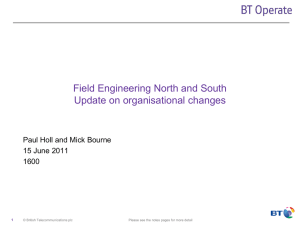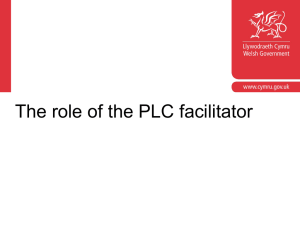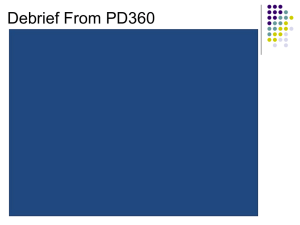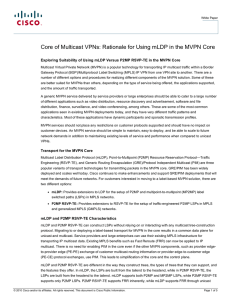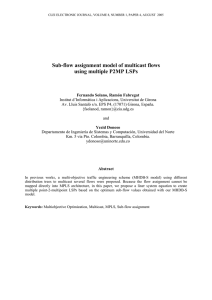Why MPLS multicast?
advertisement
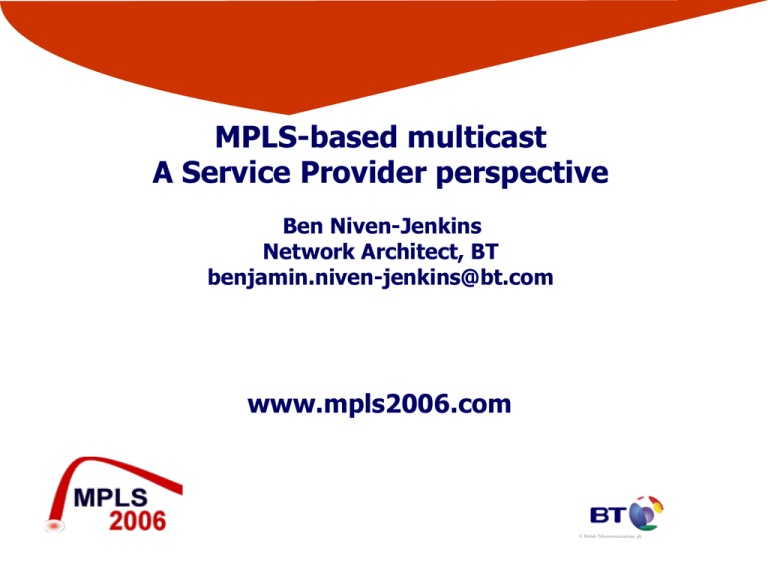
MPLS-based multicast A Service Provider perspective Ben Niven-Jenkins Network Architect, BT benjamin.niven-jenkins@bt.com www.mpls2006.com © British Telecommunications plc Agenda Why MPLS multicast? How MPLS multicast works Service provider requirements 2 © British Telecommunications plc Why MPLS multicast? MPLS was not designed with multicast from day 1 Clear requirements for multicast services P2P & MP2P only Corporate VPN Broadcast TV Finance sectors Convergence on MPLS (e.g. BT’s 21C network) draft-rosen adds multicast to RFC4364 VPNs Only supports IP/GRE forwarding not MPLS 3 © British Telecommunications plc How MPLS multicast works Two solutions, depending on requirements: mLDP (multicast LDP) Connectionless, receiver driven RSVP-TE Connection-oriented, source driven 4 © British Telecommunications plc mLDP - Overview Defines a new P2MP FEC to identify P2MP LSPs <Source IP Address of root, Opaque Value> Receiver (Leaf) initiates setup & tear down Supports P2MP LSPs MP2MP LSPs Shared Trees Make before break (optional) 5 © British Telecommunications plc mLDP - Example Label Map A B Label Map Z Label Map 6 Label Map © British Telecommunications plc RSVP-TE - Overview MPLS & GMPLS Defines new P2MP SENDER_TEMPLATE P2MP LSP is constructed from one or more Source to Leaf (S2L) sub LSPs Source (Root) initiates setup & tear down Supports P2MP LSPs Shared Trees Make before break Refresh reduction [RFC2961] Fast Reroute [RFC4090] 7 © British Telecommunications plc RSVP-TE - Example Path Resv Path Path A B Path Z Resv Resv 8 Resv © British Telecommunications plc Comparing mLSP & RSVP-TE mLDP RSVP-TE Receiver driven and therefore root does not need to know a priori about the leaf nodes. Head end driven and therefore the root has to know a priori about all the leaf nodes. Multicast state is exactly the same as RSVPTE, but the overhead of maintaining the state is lower. Multicast state to be maintained is the same as mLDP, but the overhead of maintaining the state is higher. Limited tree computation flexibility, no support for minimum cost trees. Flexible path computation based on minimum cost and shortest path. Hop by hop routing only, no explicit route support. Hop by hop routing & explicit routing using ERO with strict and loose hops. No support for bandwidth reservation in protocol but can be achieved using network planning & Diffserv. Supports bandwidth reservation. Backup path support reliant on IGP/LDP convergence. Optional make before break for planned events. Supports fast reroute and make before break capabilities. 9 © British Telecommunications plc Service Provider requirements Ideally prefer a single protocol solution Seamless migration (from deployed solutions) Globally Scalable solution 100s POP & >100 000 end user connections Multi-area & multi-AS support Management & operations that are as simple as possible Converging onto a single 21C network platform Due to network size and range of equipment Hard guarantees of performance characteristics Guaranteed 1+1 resiliency across diverse & separate paths Lowest latency path selection High availability Security (CESG approval) Government & national infrastructure 10 © British Telecommunications plc How MPLS addresses these requirements (1) Multi-area & Multi-AS support Simple management & operations mLDP: Not covered by P2MP draft RSVP-TE: Not covered by P2MP draft Management independent of protocol? Reuse existing management tools? Hard guarantees of performance characteristics mLDP: no support in protocol Can be achieved via network planning, IGP modelling, Diffserv bandwidth assignment RSVP-TE: support via TE metrics, bandwidth reservation and explicit routes 11 © British Telecommunications plc How MPLS addresses these requirements (2) Guaranteed 1+1 resiliency across diverse & separate paths Low latency path selection mLDP: no support in protocol Can be achieved via network planning & IGP modelling RSVP-TE: support via explicit routes mLDP: no support in protocol Can be achieved via network planning & IGP modelling RSVP-TE: support via TE metrics and explicit routes High availability mLDP: RR draft & implementation dependent RSVP-TE: FRR & implementation dependent 12 © British Telecommunications plc Room for improvement in MPLS multicast? Multi-vendor, interoperable implementations Reduce the no. choices in MPLS VPN multicast draft Industry needs a single solution for multicast Reduced to the lowest common denominator For both control & data planes draft-ietf-l3vpn-2547bis-mcast OAM High availability 13 © British Telecommunications plc Bibliography mLDP RSVP-TE draft-mpls-rsvp-te-p2mp-06 Multicast in MPLS/BGP IP VPNs draft-ietf-mpls-ldp-p2mp-01 draft-ietf-l3vpn-2547bis-mcast-02 Supersedes draft-rosen-vpn-mcast-08 [Expired] BGP Encodings for Multicast in MPLS/BGP IP VPNs draft-ietf-l3vpn-2547bis-mcast-bgp-00 14 © British Telecommunications plc Questions? 15 © British Telecommunications plc
